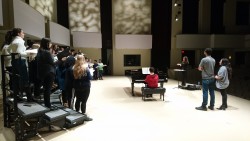
The York University choir belts out the final “Plangite (Weep)” of Carmina Burana with Lisette Canton at the helm. “No. No,” she cuts them off, “the walls better shake!” With a huge cue, high in the air, the sound rips forth and I feel it deep inside my body, vibrating my little heart. The ending to Carmina Burana is notoriously difficult to sustain, especially at a high volume. The choir brings the heat – spine-tingling, goosebump-inducing, brain-rattling excitement. I can’t wait to hear this put together with the percussion and dual piano reduction they are planning for their upcoming performance.
Carmina Burana (1937), by Carl Orff, is perhaps the most popular choral secular work ever created. It’s one of the most performed and well-loved choral works. It’s complex and interesting and equally pleasing to audience, chorister, and accompaniment alike. The text is evocative and mischievous, reflecting an odd little snippet of history created by a collection of strange monks’ poetry from about 1000 years ago. The piece is also fraught with complicated history in Nazi Germany, in which Carmina Burana was often performed and held in high-esteem. Carl Orff managed to be very successful under the Nazi regime.
Canton last led the York University Choirs in Carmina Burana in 2012. For baritone Taylor Gibbs, Carmina was part of his first year and will now be his final concert in his undergraduate studies. He’s one of only two students who have ever performed this piece before and was “so excited” when Canton announced the piece at the end of last school year. Gibbs is knowledgeable about the work, which he’s featured in as a soloist along with seven others. Rather than featuring the conventional three soloists – bass, soprano, and roasting swan tenor – Canton has spread the talent through eight soloists who also sing in the choir when not featured. Gibbs loves that Canton has played to the strengths of the soloists. “It’s great to see them, my friends, doing their thing,” says Gibbs. It’s a collegial and supportive environment to sing in.
The many soloists are helpful from an audience perspective, as well, because the roles are distinctive. The drunk Abbot of Cockaigne is a very different character than the hopeful young man of “Omnia sol temperat.” Each soloist gets to put a stamp on their performance, evoking the various characters created by the monks’ original text. I’m especially enamoured with the Blanziflor and Helena pairing. Helena (Kayla Ruiz), cradled in the arms of her Blanziflor (Sebastién Belcourt), sings “Sweetest One! I give myself to you totally.” Not only pitch perfect, the visual is simple, yet so effective.
Lisette Canton’s production is a semi-staged version of the work, not just a standard straight-up concert. The three major sections of the work will have unique staging and lighting to get at “the beauty of the experience,” says Canton. The first is titled “Spring,” the second “In Tavern,” and the third “The court of Love.” The works flow through different places and times to evoke different themes. The light freshness of “Floret Silva” (the Forest Flowers), sung earlier in the work, is markedly different than the heavy manliness of the second section’s “Estuans interius (Seething Inside)”. Canton’s production choices will shape the performance of each section differently. The choir, specifically the men, are excited about the “In Tavern” portion. They’re moving off the risers as the stage transforms into a 12th-century bar. We’ll have to see where these jaunty young men take us on the grandest choral homage to drinking ever written. The entire production is being set up to “get the whole story and the movement and intensity” of the music, says Canton.
Paying attention to the text of the work is essential to a performance of Carmina Burana. It’s racy and playful: “Mea mecum ludit virginitas (My virginity makes me frisky!)”. It’s pleasant and hopeful: “ad amorem properat animus herilis (the soul of man is urged towards love)” . It’s hilarious and light-hearted: “girat, regirat garcifer; me rogus urut fortiter (The servant is turning me on the spit: I am burning fiercely)”. At times, it’s even uncomfortable and wildly inappropriate: “Oh, totus floreo (Oh, I am bursting out all over)” (normally sung by a children’s choir and repeated many times). Orff has created a story from these bizarre writings and Carmina Burana is a fantastical musical journey.
York University’s music program continues to provide an exemplary interdisciplinary arts education in the School of the Arts, Media, Performance, and Design. The students keep coming back too, they “keep singing,” says Canton. Several alumni are part of this performance. If you’ve never been to see a York choral ensemble in action, I highly suggest you catch the choirs in their presentation of Carmina Burana. Canton promises wall-shaking sound, “top-notch soloists and choir,” and drinks in the lobby afterwards.
Follow Brian Chang on Twitter @bfchang. Send info/media/tips to choralscene@thewholenote.com.



